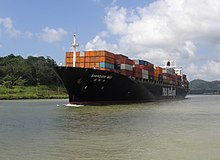Panamax

"Panamax" ships are of the maximum dimensions that will fit through the locks of the Panama Canal. This size is determined by the dimensions of the lock chambers, and the depth of the water in the canal. An increasing number of ships are built precisely to the Panamax limit, in order to transport the maximum amount of cargo in a single vessel. A lot of bulk merchandise, such as grain products, are moved primarily on Panamax (or sub-Panamax) ships.
The increasing prevalence of vessels of the maximum size is a problem for the canal. A Panamax ship is a tight fit that requires precise control of the vessel in the locks, possibly resulting in longer lock time, and requiring that these ships be transited in daylight. Because the largest ships cannot pass safely within the Gaillard Cut, the canal effectively operates an alternating one-way system for these ships.
Dimensions

Panamax is determined principally by the dimensions of the canal's lock chambers, each of which is 33.53 metres (110 ft) wide by 320.0 metres (1050 ft) long, and 25.9 metres (85 ft) deep. The usable length of each lock chamber is 304.8 metres (1000 ft). The available water depth in the lock chambers varies, but the shallowest depth is at the south sill of the Pedro Miguel Locks and is 12.55 metres (41.2 ft) at a Miraflores Lake level of 16.61 metres (54 feet 6 in). The height of the Bridge of the Americas at Balboa is the limiting factor on a vessel's overall height.
The maximum dimensions allowed for a ship transiting the canal are:[1]
- Length: 294.1 metres (965 ft)
- Beam (width): 32.3 metres (106 ft)
- Draft: 12.0 metres (39.5 ft) in tropical fresh water (the salinity and temperature of water affect its density, and hence how deep a ship will float in the water)
- Air draft: 57.91 metres (190 ft) measured from the waterline to the vessel's highest point
A Panamax cargo ship would typically have a displacement of around 65,000 tons.[2]
Exceptions

Vessels up to 62.5 metres (205 ft) in height may pass by prior approval, co-ordinated with low tide at the Bridge of the Americas.
From time to time, vessels up to 32.61 metres (107 ft) in beam may be permitted to transit, subject to additional draft constraints.
Vessels with structures extending beyond the maximum length and/or beam above the level of the lock walls may be permitted transit subject to inspection and approval.
During an exceptionally dry season, when the water level in Lake Gatún is low, the maximum permitted draft may be reduced.
The longest ship ever to transit was the San Juan Prospector, now Marcona Prospector, an ore-bulk-oil carrier that is 296.57 metres (973 ft) long, with a beam of 32.3 metres (106 ft).[3] The widest ships to transit are the two North Carolina class battleships, USS North Carolina (BB-55) and USS Washington (BB-56), which have beams of 33.025 metres (108 ft 3.875 inches).[4]
Post-Panamax ships
Post-Panamax or over-Panamax denote ships larger than Panamax that do not fit in the canal, such as supertankers and the largest modern container ships. U.S. Navy supercarriers are also in the post-Panamax class; the Nimitz class aircraft carriers are 333 metres (1092 ft) long overall with a beam of 41 metres (134 ft), while the flight deck is 76.8 metres (252 ft) wide.
Expansion

As early as the 1930s, new locks were proposed for the Panama Canal to ease congestion and to allow larger ships to pass.
On October 22, 2006, the Panama Canal Authority (with the support of the Electoral Tribunal) held a referendum for Panamanian citizens to vote on the Panama Canal expansion project. The expansion was approved by a wide margin, with support from about 78% of the electorate. It is estimated that the project will be completed by 2014 and will cost $5.3 billion; this sum is expected to be recovered within 11 years.
After this expansion, the Panama Canal will able to handle vessels up to 12,000 twenty-foot equivalent units (TEU) in size; currently, it can only handle vessels up to about 5,000 TEU. A third set of locks – 427 metres (1,400 ft) long, 55 metres (180 ft) wide, with a draft of 18.3 metres (60 ft) – will supplement the two existing sets.
Comparison of sizes
| Class | Panamax | Panamax II |
|---|---|---|
| Length | 1050 ft (320.04 m) | 1400 ft (426.72 m) |
| Width | 110 ft (33.53 m) | 180 ft (54.86 m) |
| Draft | 41 ft (12.50 m) | 60 ft (18.29 m) |
| TEU | 5000 | 12000 |
New Panamax
As a result of expansion works a novel size group "New Panamax" was defined.[5]. Maximum length overall will be 366 m (1200 ft), beam 48.8 m (160 ft) and draft in tropical freshwater 15.2 m (50 ft). Naval architects and engine designers are already taking into account this dimensions for container ships[6].
See also

- Aframax
- Capesize
- Handysize
- Liberty ship
- List of deep water ports
- Malaccamax
- Panama Canal expansion project
- Seawaymax
- Suezmax
- ULCC
- VLCC
References
- ^ Vessel Requirements, from the Panama Canal Authority
- ^ Modern ship size definitions, from Lloyd's register
- ^ Background of the Panama Canal, Montclair State University
- ^ Battleships, United States Battleships in World War II, by Robert O. Dulin, Jr. and William H. Garzke, Jr.; pages 62 and 145. Naval Institute Press, 1976. ISBN 0-87021-099-8
- ^ ACP: Dimensions for Future Lock Chambers and “New Panamax” Vessels
- ^ Propulsion Trends in Container Vessels MAN B&W Two-stroke Engines
